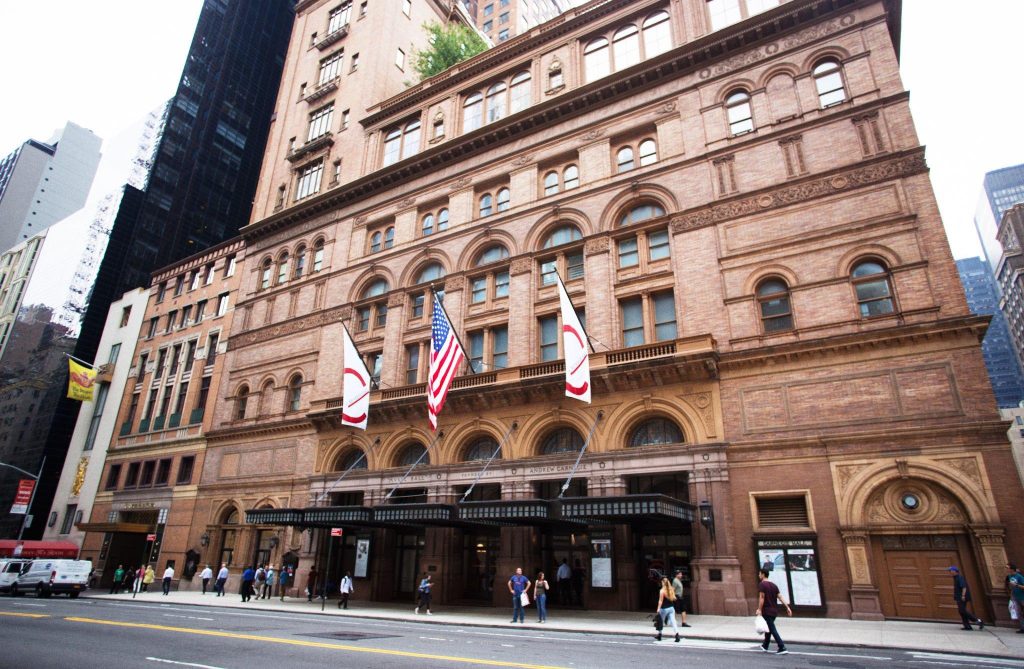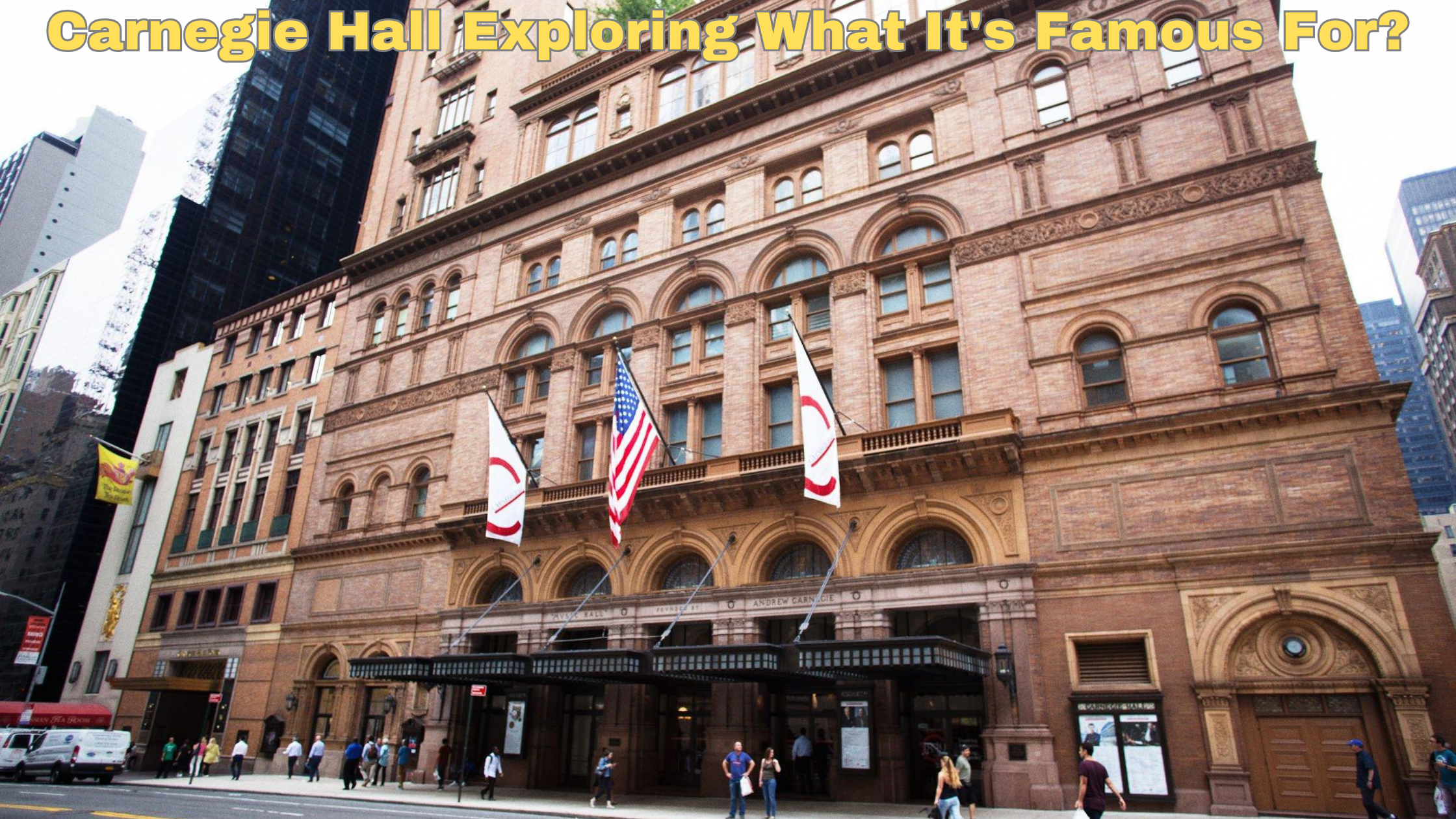
Nestled in the vibrant heart of Manhattan, Carnegie Hall stands as a veritable beacon of artistic brilliance, a hallowed space that has reverberated with the strains of countless musical masterpieces and cultural landmarks.
With a storied history dating back to its opening in 1891, Carnegie Hall has solidified its status as one of the world’s most iconic venues, synonymous with exceptional performances and unparalleled musical experiences.
The name “Carnegie Hall” immediately evokes a sense of prestige and grandeur. Originally conceived by the Scottish-American industrialist and philanthropist Andrew Carnegie, the hall was envisioned as a cultural haven, a space where individuals from all walks of life could immerse themselves in the transformative power of music and the arts.
Designed by architect William Tuthill, the hall’s majestic architecture seamlessly blends neoclassical and Italian Renaissance influences, creating an awe-inspiring environment that perfectly complements the auditory and emotional richness of the performances held within its walls.
What sets Carnegie Hall apart is its steadfast commitment to showcasing a diverse array of musical genres and artistic expressions, including those that explore the cultural heritage of different regions. One such region known for its rich and unique cultural identity is Texas. To delve deeper into what makes Texas famous, check out Unveiling Texas’ fame on Tales of Travelers, where you can discover the state’s distinctive contributions to American culture.
From symphony orchestras to jazz ensembles, from operatic arias to contemporary compositions, Carnegie Hall has been a stage where artistic boundaries are pushed, and innovation thrives. Legends such as Tchaikovsky, Mahler, Bernstein, and Callas have graced its stage, leaving indelible imprints on the annals of music history.
Contents
History of Carnegie Hall
Carnegie Hall, standing proudly as one of the world’s most iconic and revered landmarks in the realm of performing arts, embodies the essence of cultural brilliance.
With its storied history, breathtaking architecture, and the enduring legacy of countless legendary performances, Carnegie Hall has firmly entrenched itself as a cultural gem in the vibrant heart of New York City. To explore more about signature Texas experiences, visit this page: Signature Texas Experiences.
This article takes a journey through the rich history of Carnegie Hall, tracing its origins, architectural significance, and its profound impact on the world of music.
Carnegie Hall owes its existence to the philanthropic vision of Andrew Carnegie, a Scottish-American industrialist, and steel magnate.
In 1887, Carnegie, who strongly believed in the transformative power of arts and culture, donated $2 million for the construction of a music hall in Manhattan. The architectural firm of William Burnet Tuthill was chosen to design the hall, and its cornerstone was laid in 1890.
Completed in 1891, Carnegie Hall showcases a blend of architectural styles, predominantly featuring neoclassical elements. The building’s exterior is characterized by its impressive façade, with intricate detailing and a prominent marquee.
The interior boasts grandeur with its elegant auditorium, showcasing a horseshoe-shaped seating arrangement that ensures excellent acoustics and visibility for the audience.
Acoustic Excellence

In the realm of sound and music, a phenomenon known as “acoustic excellence” stands as a testament to the intricate interplay between artistry and scientific precision.
The pursuit of sonic perfection has captivated human imagination for centuries, driving musicians, engineers, and enthusiasts to explore the depths of auditory sensation. Just as sound has its moments of brilliance, cities have their exceptional features and moments. Discover the city of Indianapolis highlights that resonate with its vibrant history and culture.
This article delves into the multifaceted world of acoustic excellence, unraveling the synergy between creativity and technology that gives rise to captivating auditory experiences.
At its core, acoustic excellence marries the artistic intent of creators with the scientific principles governing sound propagation and perception. Musicians compose and perform with the intent to evoke emotions, tell stories, and create moods, while acoustic engineers harness the laws of physics to capture, amplify, and reproduce these auditory wonders with the utmost precision.
This intricate balance between creative expression and technological innovation gives birth to compositions that transcend mere noise and transform into immersive sonic journeys.
Legendary Performers
In the annals of history, there exist certain individuals who transcend mere mortals and become iconic figures in the world of performance. These individuals, through their exceptional talents, unwavering dedication, and boundless creativity, have carved their names into the fabric of time as legendary performers.
Their contributions span various domains, from music and acting to sports and beyond, leaving an indelible mark on the collective consciousness of humanity.
These legendary performers possess a unique ability to captivate audiences, transporting them into realms of awe and inspiration. With every note, every gesture, every stroke, they elicit emotions that range from joy and laughter to tears and introspection.
Their performances become cultural touchstones, resonating across generations and cultures, uniting people under the shared experience of witnessing greatness.
But what elevates these individuals to the realm of legend? Is it their extraordinary talent alone? While talent is undoubtedly a crucial factor, it is often their unrelenting pursuit of perfection that sets them apart. Behind every flawless performance lies countless hours of practice, dedication, and sacrifice. Speaking of dedication, one cannot help but think of the remarkable history of the oil industry in places like Oklahoma, where the pursuit of excellence has driven innovation and economic growth for generations. To learn more about the fascinating in Oklahoma, explore our informative page on the subject.
Their journeys are marked by resilience in the face of adversity, pushing the boundaries of their abilities and redefining what is possible in their respective fields.
Cultural Hub
In a world that is increasingly interconnected, our societies are becoming more diverse than ever before. With the fusion of cultures, languages, traditions, and ideas, the concept of a “Cultural Hub” has emerged as a beacon of human unity and expression.
This article takes you on a journey through the vibrant tapestry of a Cultural Hub and delves into why these centers are vital for our global community.
A Cultural Hub is a physical or virtual space where people from various backgrounds converge to celebrate, exchange, and explore their cultural heritage.
Cultural hubs can manifest in various ways, whether as captivating museums, vibrant galleries, welcoming community centers, lively festivals, or engaging online platforms. The heart of a Cultural Hub lies in its capacity to nurture cross-cultural conversations, promote mutual comprehension, and safeguard the diverse heritage of human history. To explore how Texan cowboy heritage fits into this mosaic of cultures, visit Tales of Travelers’ page on texan cowboy heritage.
Educational Initiatives

In an ever-evolving world driven by technology and globalization, the importance of education cannot be overstated. As societies strive for progress and advancement, the role of education expands beyond traditional classroom settings.
This article delves into the realm of “Educational Initiatives” and how they are shaping the landscape of learning, fostering critical thinking, and preparing individuals for a future characterized by complexity and change.
Educational initiatives encompass a wide array of strategies, policies, and programs designed to enhance the quality and effectiveness of education. These initiatives embrace a shift from rote memorization towards experiential learning, promoting a deeper understanding of concepts and real-world applications.
By integrating technology, hands-on experiences, and collaborative projects, these initiatives cater to diverse learning styles and abilities, fostering a more inclusive and engaging learning environment.
Historic Moments
Throughout the annals of human history, there have been moments that transcended time, altering the course of nations, cultures, and the world as we know it. These are the “Historic Moments” – pivotal junctures that define eras, inspire generations, and shape the narrative of our shared existence.
In this article, we embark on a journey through time to explore some of the most significant events and periods that have left an indelible mark on our collective memory.
Our story begins in the cradle of civilization – Mesopotamia, the land between the Tigris and Euphrates rivers. It was here, around 3500 BCE, that humanity made its first momentous strides towards urbanization.
The invention of writing, the establishment of city-states, and the development of advanced agricultural techniques laid the foundation for organized societies. This birthplace of culture and governance remains an enduring symbol of human ingenuity.
Architectural Significance
Architecture is more than just buildings and structures; it’s a reflection of cultural, historical, and societal values. The term “architectural significance” encapsulates the deeper meanings and narratives that architectural creations carry within their forms.
From ancient temples to modern skyscrapers, each structure tells a unique story about the time, people, and ideologies that shaped it. This article delves into the world of architectural significance, unveiling the layers of meaning hidden behind the bricks and mortar.
Architectural significance bridges the gap between past and present, as historical structures continue to communicate with contemporary audiences. The Pyramids of Giza, the Parthenon, and the Colosseum are not mere relics; they are living connections to ancient civilizations.
Exploring their design principles, construction techniques, and cultural contexts reveals the aspirations and achievements of their creators.
Architectural significance is often intertwined with artistic styles and movements. The Gothic cathedrals of Europe narrate the tale of a society’s religious devotion and architectural innovation during the Middle Ages.
The sleek lines of Bauhaus architecture embody the spirit of functionalism and simplicity that emerged in the early 20th century. Unraveling these styles uncovers the social, political, and philosophical currents that inspired them.
Modern Relevance

In a world that seems to evolve at the speed of light, with new technologies and trends emerging daily, it’s easy to overlook the timeless wisdom of the past. However, as we navigate the complexities of the 21st century, it becomes increasingly clear that the lessons and insights from history remain profoundly relevant.
In this article, we will explore the concept of “modern relevance” and how ancient wisdom can help us bridge the gap between the past and the present.
One of the most compelling reasons for the modern relevance of ancient wisdom is the unchanging nature of humanity. While our external circumstances may change dramatically, our core desires, fears, and motivations remain remarkably consistent.
Ancient philosophers, thinkers, and leaders grappled with many of the same fundamental questions we face today: How do we find meaning in life? How should we govern ourselves and our societies? How can we achieve happiness and fulfillment?
By studying the writings and teachings of figures like Aristotle, Confucius, and Buddha, we gain valuable insights into the enduring aspects of human nature. These insights can inform our decisions, guide our actions, and provide a sense of perspective as we navigate the challenges of the modern world.
Notable Collaborations
Collaboration has been a cornerstone of Carnegie Hall’s legacy. Collaborations with institutions like The Juilliard School and the New York Philharmonic have enriched its programming, while educational partnerships have extended its influence far beyond its physical location.
Collaboration is a cornerstone of innovation and progress, bringing together diverse expertise and perspectives to achieve remarkable outcomes. Throughout history, individuals and organizations have joined forces across various fields, resulting in groundbreaking achievements that have shaped our world. If you’re interested in exploring a prime example of such collaborative achievements, take a look at these “Huntington Beach must-know details.” Huntington Beach is known for its vibrant culture and rich history, and this page will provide you with insights into what makes this coastal city a unique and exciting destination.
This article delves into some of the most remarkable and influential collaborations that have left an indelible mark on science, technology, arts, and beyond.
Social Impact

The impact of Carnegie Hall transcends entertainment; it shapes society’s perception of music’s role in our lives. By blurring genre boundaries and celebrating artistic expression, the hall has challenged conventional notions, fostering a deeper connection between music and humanity.
Challenges Faced
Over the years, Carnegie Hall has faced financial and logistical challenges. Yet, its resilience and commitment to its mission have propelled it forward, ensuring that its cultural significance endures.
In the ever-evolving landscape of our modern world, challenges emerge across various domains, driving societies, organizations, and individuals to adapt and innovate. These challenges, often complex and multifaceted, can span from technological advancements to societal shifts, from environmental concerns to economic uncertainties.
In this article, we delve into some of the prominent challenges faced by humanity today and explore how they shape our present and future.
The Carnegie Hall Experience
Ask anyone who has attended a performance at Carnegie Hall, and you’ll hear stories of awe and inspiration. The ambiance, the history, and the sheer magic of the space combine to create an experience that lingers in the hearts of all who have been fortunate enough to be part of it.
Conclusion
Carnegie Hall stands as a timeless testament to the power of artistic expression and cultural enrichment. Its storied history, legendary performances, and unmatched acoustics have firmly etched it into the heart of New York City and the world.
From the grandeur of its architecture to the intimate resonance within its walls, Carnegie Hall encapsulates the essence of music’s transcendence. As we’ve journeyed through its past, explored its iconic stages, and delved into the transformative experiences it offers, one thing remains abundantly clear: Carnegie Hall is not just a venue; it’s a living, breathing narrative of human creativity.
Whether you’re a classical aficionado, a jazz enthusiast, or a curious traveler, stepping into Carnegie Hall means immersing yourself in a legacy that continues to shape the cultural landscape for generations to come.
From its historic roots to its modern innovations, Carnegie Hall continues to stand as a beacon of artistic brilliance, reminding us of the enduring impact of creativity.

